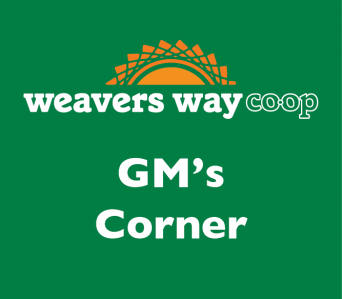
GM's Corner: It’s Time to Start Talking About the Future of Our Flagship Store
I write this column with trepidation, as I am about to commit Co-op heresy: I’m going to be critical of our Mt. Airy store.
Actually, before I do, let me stress that I truly love the store. It has been described — quite correctly — as Mt. Airy’s living room, and first-time visitors often comment on how they wish their neighborhood had a store just like it.
Our Mt. Airy store epitomizes the idea of a community “third place “ — those essential, almost magical spaces where one can feel a community’s pulse. Any neighborhood in the city would be blessed to have such a place. Mt. Airy is fortunate.
All that being said, there are, to put it mildly, problems.
Fundamentally, there is a mismatch between the store’s size and its sales volume. Back in 2010, we opened our Chestnut Hill store in part to take pressure off of Mt. Airy, which was, as we all said at the time, “bursting at the seams” with sales that had climbed to over $8 million annually. Ten years later, annual sales in Mt. Airy are approaching $13 million.
The sales volume of our Mt. Airy store is outlandish. From time to time we engage outside industry experts who take a look at our figures and at first assume there’s an error. A store that size, they tell us, can’t possibly do that kind of volume.
Beyond the size-versus-volume misalliance, the store comes with a long list of inconveniences and annoyances. Want to shop bulk? That’s upstairs. Need pet food? Across the street. No room for a hot bar, salad bar or rotisserie chickens.
The small space means limited selection, which means fewer sizes, flavors and brands. And room for beer and wine? Fuggetaboutit.
Operational inefficiencies further detract from the customer experience and add to operating costs. Deliveries must be received on Greene Street. Pallets must be broken down outside and carted into the building. People must walk past our trash and recycling dumpsters, an eyesore any time of year, and an affront to the senses during a heat wave.
The store’s narrow aisles make it challenging to shop with a stroller or walker and impossible for anyone in a wheelchair. Bathrooms are upstairs or next door, and none of them are handicapped accessible.
All of this has the effect of eroding the shopping experience. In the highly competitive grocery biz, the shopping experience matters. Even the most devoted customers will tire of large crowds, long checkout lines and limited selection.
All of these problems are nothing new, but in recent months the pandemic has made a bad situation worse.
Social distancing in the Mt. Airy store is oxymoronic, but limiting crowds to no more than 12 customers at a time at least helps. The inevitable sidewalk queue is yet another inconvenience. It’s tolerable if the weather is cooperative, but how much business have we lost when people, seeing a line stretching as many as 15 customers long, keep on driving?
Many have chosen to drive to Ambler. Even before the pandemic, some Co-op members who live in Mt. Airy and Chestnut Hill (our Chestnut Hill store suffers many of the problems we have in Mt. Airy) had taken to driving to our Ambler store, only about 20 minutes away.
In Ambler, the customer experience includes such “luxuries” as ample parking, bathrooms compliant with the Americans with Disabilities Act, wide aisles, big shopping carts and a bulk department that doesn’t require climbing stairs.
Those of us familiar with shopping in our Mt. Airy or Chestnut Hill stores often describe our Ambler store as “huge” or even “too big.” We need to remind ourselves that in the grocery biz, at 11,000 square feet the store is positively puny (people who’ve never been to our Mt. Airy or Chestnut Hill stores tend to describe Ambler as “cute”).
But it is big by our standards, and its size, beyond generally improving the customer experience, also allows for things that are temporarily on hold due to the pandemic, like our Friday night community dinners and vendor tasting events.
I am not — repeat not! — advocating moving our Mt. Airy store to a new location. It is part of the culture of our Co-op, a community nexus and an iconic retail institution, comparable to Termini Brothers Bakery or the Mayfair Diner.
I am suggesting that we begin having a conversation about what makes sense for our Co-op in the years ahead. A consumer cooperative exists to meet the needs of its members. How can we best ensure we meet the needs of our Mt. Airy members well into the future?
See you around the Co-op.
